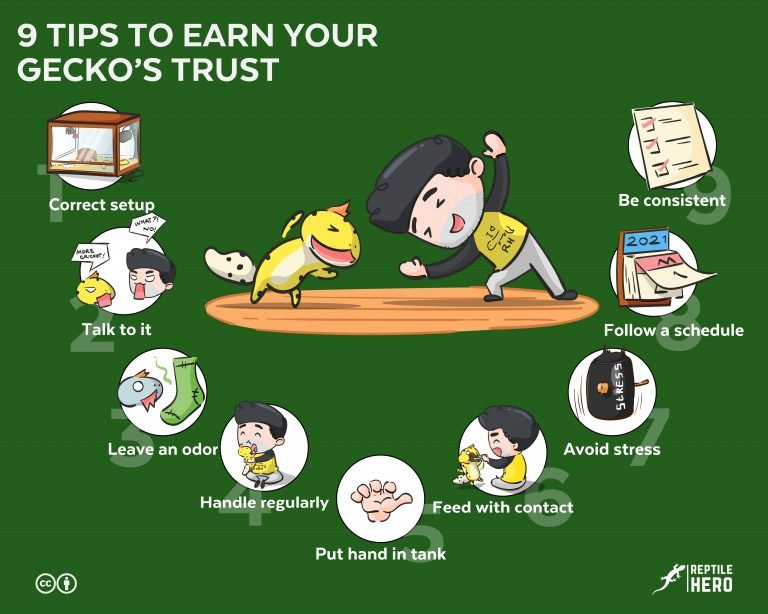Should You Let Your Leopard Gecko Free-Roam in the House?
Can we let leopard geckos have their own little adventures out of their tanks from time to time? Is it really okay to have them free-roam? All I can say is that it’s definitely doable. But you do need to prepare before letting your leo explore outside its enclosure. There are also dangers to look out for when letting geckos roam freely!
Leopard gecko owners can only have their geckos free-roam in the house inside a playpen or enclosed reptile-safe room under strict supervision. The main purpose of free-roaming is enrichment. However, keepers and breeders must ensure that the area is completely safe to prevent leopard geckos from getting stuck or injured.
Some people allow their leos to roam freely while others strongly oppose it. Both sides have valid reasons for their decisions. I’m here to tell you all about them so you can decide for yourself!
Can You Have Leopard Geckos Roam Freely at Home?
With close supervision and proper preparations, keepers and breeders can allow leopard geckos to roam freely in a secure space. However, they must always have a correctly set up enclosure to return to after each free-roam session.
Although others see free-roaming as a way of permanently keeping leopard geckos and other reptiles in captivity without suitable enclosures, this isn’t the only definition. However, in such cases, I do agree that no captive reptile should be allowed to roam freely at all times.
Unless you live in Pakistan, or any other nearby country, where leopard geckos are native, it will be impossible to keep them as pets without appropriate housing.
More importantly, in the event that they escape into their natural home range, they don’t present serious problems to their local environments—they belong there! We can’t say the same for leopard geckos living in America or any other country outside of South Asia.

So to be absolutely clear, when I say you can let leos roam freely at home I am referring to free-roam as a time-limited, out-of-enclosure activity for leopard geckos.
Most pet leopard geckos are cooped up in tiny tanks that have little to no furnishings and decors save for a hide or two and a water bowl. Such barren set-ups and outdated care make gecko-keeping easy. But such benefits for owners come to the detriment of geckos!
If we keep intentionally limiting our lovely leopard geckos, how can they reach their full potential as smart animals?
Learn more about their cognitive abilities in our article on gecko intelligence.
Like any other sentient creature, without being stimulated and challenged both physically and mentally, geckos are not going to thrive!
How Does Free-Roaming Benefit Leopard Geckos?
Allowing leopard geckos to free-roam in a safe space gives them enriching opportunities to exercise and explore—encountering novel items. Hence, free-roaming can improve not only their physical health but also their mental health.
In the wild, leopard geckos are naturally able to roam freely in a completely open area but this cannot be replicated in captivity. So, we can give them the next-best option instead—free-roaming.
Of course, you can’t let your gecko freely roam all around your apartment or house like you would with cats and dogs. But it’s not impossible to give them safe free-roam sessions in a secure room under your supervision!
By letting leopard geckos free-roam, you are encouraging natural exploratory behaviors and preventing boredom which would otherwise cause significant stress. Extremely bored geckos may even start hurting themselves out of pure restlessness!
Want to know more? Read our article on gecko boredom!
Now, to be completely honest, there isn’t much research on the topic to prove that free-roaming is indeed highly beneficial for leopard geckos, specifically. But some studies exploring the effects of free-roaming in reptiles do back up my points.
Research shows that free-roaming can improve reptile welfare [1]. Regular free-roam sessions can lower stress and decrease—if not eliminate—non-functional repetitive behaviors like pacing along the front of the enclosure.
Experts call such actions stereotypic behaviors or stereotypies. One of the most common examples of stereotypic behavior in leopard geckos is glass-surfing—which can be stopped and prevented by providing enrichment including free-roam sessions.
Can you let other geckos free-roam?
It is easier to let geckos free-roam if they are a terrestrial species and they are similar in size to leopard geckos. Arboreal geckos can jump up walls and ceilings so they can be harder to get after free-roam sessions. Other than that, small geckos can get lost easily while bigger geckos can knock over things and cause serious accidents.
5 Problems of Free-Roaming Leopard Geckos (With Solutions!)
Leopard geckos can be in danger if they are not supervised while free-roaming and if the area is not prepared and secured beforehand. In effect, leopard geckos can get stuck, lost, and injured. They may also escape and even die.
The situation can go south pretty quickly if no care is put into preparing a safe area for leopard geckos to free-roam.
So familiarize yourself with the possible consequences and take note of the ways you can prevent and resolve these issues!
1. Getting Stuck
Leopard geckos are small animals that like taking shelter in dark crevices so they can easily get themselves stuck while trying to fit into tight spaces.
Also, while their claws are sharp, they can still get caught in the carpet and other textured fabrics in the room during free-roam sessions.
Solution: Cover up any nook and cranny that your gecko may squeeze itself into and remove rugs and carpets they can get stuck on.
2. Being Lost
These terrestrial geckos are adept runners. You’d be surprised at how you could lose sight of your leopard gecko while it’s free-roaming!
So if you’re planning to let your gecko roam in a room that you are unfamiliar with yourself, all I can say is good luck in finding your leo once the free-roam session is done.
Solution: Make sure they can’t hide anywhere and supervise them closely. If want to take things up a notch, install a camera (here on Amazon) in the room you’ll be letting your leo roam in.
Curious about our recommendation? Learn more in our article on choosing the perfect gecko camera.
3. Sustaining Injuries
A lot of the ordinary things we have in our house can potentially injure leopard geckos, besides normally sharp objects that could wound or poke them.
They could, for instance, electrocute themselves if they come into contact with a power strip on the floor. Accidentally ingesting essential oils—if you use any—which dropped to the floor is another possibility since they normally lick things to inspect them.
Solution: Clear away any objects that could be dangerous from the floor to keep them out of your gecko’s reach and minimize potential harm. Keep an eye out for things that could also fall on them while they are roaming about.
4. Escaping
Despite being a relatively rare occurrence, your leopard geckos may escape if you’re not closely watching them.
This can happen if there are holes on the floor or by the base of the walls that are not readily noticeable at first glance, especially if you have dark-colored floors.
Solution: Secure the area before letting your leopard gecko freely roam around. Close the doors to the room and/or use a playpen so that it’s easier for you to prevent them from escaping.
Where should you let leopard geckos free-roam?
Avoid having geckos roam in the kitchen as they can be carrying salmonella which they could pass to you without showing any symptoms. Don’t let them free-roam in rooms with strong chemical solutions including bathrooms and garages.
5. Dying
Unfortunately, I have heard stories of leopard geckos dying at the paws and claws of other pets that are much bigger than them while they are wandering about during a free-roam session.
Though it’s exciting to have a chance to snap a cute picture of your cat or dog “bonding” with your leo, I would strongly discourage you from trying it out.
Solution: Prioritize your leopard gecko’s safety. Keep them away from your other, much bigger pets while they are roaming freely outside their enclosure.
Discover other ways to protect your scaly babies in our article on keeping geckos safe form cats.
How do you get free-roaming leopard geckos to return to their tanks?
Ideally, leopard geckos should be able to choose when to get out our their tanks to free-roam and when to return. Choice-based free-roaming can be done by training leopard geckos to perform a specific action before letting them out and placing a ramp in front of their tank door so they can return when they want to go back inside.
Dos and Don’ts Before Letting Your Gecko Free-Roam
Letting leopard geckos free-roam requires careful consideration and planning from the owner to ensure the reptile’s comfort and safety.
Keep in mind that not all leos may be keen on the prospect of being out of their enclosure for extended periods. Plus, free-roaming could do more harm than good for some geckos.
Don’t make a leopard gecko free-roam if:
- The gecko is still sleeping, especially during the day
- The gecko is not yet used to handling and physical contact
- The gecko is sick or recovering—regardless if it’s contagious or not
- The gecko still hasn’t completed the required quarantine period
Make the most out of free-roam sessions by putting your precious leopard gecko’s well-being as your top priority.

Remember to do these before and while having a leopard gecko free-roam:
- Block out loud noises to avoid startling the gecko.
- Clean the free-roam space beforehand.
- Remove insect and mouse traps, if there are any.
- Keep the room warm at 80–90°F or 26–32°C.
- Allow only one gecko to roam at a time.
- Observe the gecko’s behavior while it’s roaming.
Further Questions
Should you turn off the lights while letting your gecko free-roam?
It is recommended to have the lights on while a gecko is free-roaming to avoid accidentally stepping only them and losing sight of them in the dark. However, to avoid giving them too much light at night which can disrupt their day/night cycle, let geckos roam early in the morning or late in the afternoon—around dawn and dusk.
How long should geckos be out of their tanks?
Geckos should generally only be let out of their tanks for a minimum of 10 minutes to a maximum of 1 hour. Such time frames should be enough to provide the leopard geckos with novel experiences while free-roaming without letting them cool off too much outside of their optimally heated tank.
Do geckos like to be out of their enclosure?
Not all pet geckos seem to like being taken out of their enclosure, especially if they are still young and new. However, with consistent handling and free-roam sessions, geckos are likely to become accustomed to regularly being out of their enclosure for short periods.
Is it okay to release geckos in the house for pest control?
It is not advisable to release pet geckos inside residential places like homes for pest control. Unknown bugs could be carrying harmful bacteria and may have traces of toxic plants and chemicals in their bodies which could poison and kill leopard geckos if eaten.
Can you let live feeder insects free-roam in your gecko’s enclosure?
Owners can present live feeder insects to geckos by letting them free-roam around the enclosure one at a time to encourage natural hunting behaviors. This ensures that all insects offered to the gecko are eaten. Do not dump numerous insects into the enclosure as this may overwhelm the gecko.
Summary of Should You Let Your Leopard Gecko Free-Roam?
Free-roaming should only be done temporarily for enrichment and not permanently as a way to keep geckos in captivity. People should never keep leopard geckos in captivity if they cannot provide them with a secure and appropriate enclosure.
It is important to keep in mind that the room should be kept safe and prepared properly before the gecko is allowed to free-roam. Otherwise, leopard geckos are at risk of getting stuck, being lost, sustaining injuries, escaping, and—in rare instances—dying.



![Ceramic Heater vs Halogen For Leopard Gecko: Which is Best? [11 Factors]](https://www.reptilehero.com/wp-content/uploads/2021/08/che-halogen-comparison-gecko-small-cover-infographic.jpg)
![Taking Care of Geckos During Power Outages [Final Guide]](https://www.reptilehero.com/wp-content/uploads/2021/04/Gecko-Care-Power-Outage-768x614.jpg)

